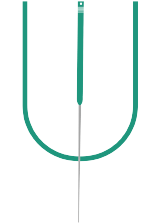Chinese Medicine
With only 4 acupuncture treatments, I saw a tremendous improvement in my bronchial asthma that has been bothering me for years, my period improved after a year and my cholesterol dropped to normal levels. Efthymios, thank you again.
– Alexandra A.
What is Chinese Medicine?
Traditional Chinese medicine has a history of thousands of years and has changed little over the centuries. Its basic idea is that a vital force, called Qi, permeates the body. Any imbalance in Qi can cause dysfunctions and diseases.
The duality that exists everywhere in nature and man, is symbolically explained by the ancient Chinese with the image of a mountain. The side that is in shade was called yin, while the side that receives the sun’s rays, is yang. These two forces and actions are considered opposite in the West, while Chinese Medicine focuses on the relationship they have with each other, as interrelated, interdependent, and complementary since one is necessary for the existence of the other and the general balance.
The ancient Chinese believed that humans are a microcosm of the wider environment of the universe, are intertwined with nature, and are subject to its powers. The balance between health and disease is a basic concept. Treatment using Traditional Chinese Medicine seeks to restore this balance through specially adapted therapy for the individual. It is believed that to regain balance, the balance between the internal organs of the body and the external elements of Water, Wood, Fire, Earth, and Metal must be achieved
Classical Chinese Medicine
All forms of Acupuncture originate from the book Huang Di Nei Jing which was formed at some point prior to 220 BC. This text was destroyed in 960 AD by the Song Dynasty. In its original form it described all 68 channels of Acupuncture which were practised to treat psycho-emotional conditions and chronic degenerative diseases as well as to preserve health. After its alteration the 68 channels were reduced to 12, the meridians called Primary channels which most practitioners use these days worldwide under the modality called Traditional Chinese Medicine (TCM) which was formed in the 1950’s.
Dr Jeffrey Yuen is the 88th generation holder of the Yu Qing Huang Lao Pai and has received all the teachings that predated the destruction of the original text of Huang Di Nei Jing, through oral tradition. Ann Cecil-Sterman is one of the original students of Jeffrey Yuen. She followed him closely for 22 years and compiled the entirety of his teachings on the 68 acupuncture channel system. In 2023 she began offering her intense six month mentorship program where this knowledge is given in a concentrated form. I had the honour to be one of the 120 students to have graduated from it worldwide and the only one in Greece
Acupuncture treats the person holistically and to do so makes a diagnosis through the prism of Chinese medicine. Thus, when receiving an acupuncture treatment you will not be treated for your given Western medical diagnosis.
For example, you might suffer from gripping headaches behind the eyes or around your temples, known with the Western term of migraines. Chinese medicine understands that this is caused most often by a tightening of the Gallbladder energy channel, in an attempt to reserve blood, in which we might be deficient. The treatment would not have purely the function of a painkiller, something to stop us from feeling the pain, but instead it would address the real cause of the symptom. We would nourish the blood via acupuncture and we would offer advice on how to include hydration through the diet. We would also give you some information on foods, substances and habits that are dehydrating and could be anywhere from counter-productive to causing the blood deficiency and ultimately the painful migraines.
That said, the World Health Organization recommends acupuncture as it has been proven, through controlled trials, to be an effective treatment for over 100 conditions.
Find MoreTreatment to restore balance may include:
Acupuncture
(Acupuncture is part of traditional Chinese medicine commonly found in Eastern medicine and has received the largest study of all alternative therapies.)
Find MoreMoxibustion
(moxa therapy: burning of the plant Artemisia, in specific acupuncture points or channels)
Suction cups
(Use of containers made of glass, plastic or silicone to create suction in certain parts of the body)
Find MoreQi Gong
Movement and concentration exercises
